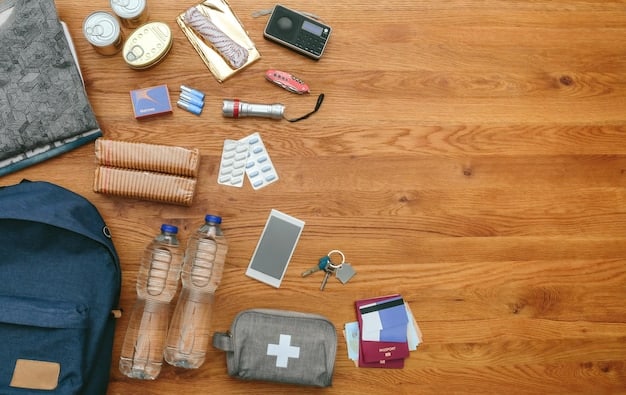Severe Weather Prep: Your 72-Hour Power Outage Survival Guide

Severe weather alerts often lead to power outages; preparing a 72-hour emergency kit with food, water, communication devices, and backup power sources is crucial for safety and comfort.
When a severe weather alert hits, the threat of a 72-hour power outage becomes very real; are you ready to face it?
Understanding the Risks of Severe Weather Power Outages
Severe weather events are becoming more frequent and intense, leading to an increased risk of power outages. Knowing the specific threats and vulnerabilities in your area is the first step in preparing for a 72-hour power outage.
Common Weather Events Leading to Outages
Different types of severe weather can cause power outages; here are some of the most common:
- Hurricanes: Strong winds can knock down power lines, causing widespread outages. Coastal areas are particularly vulnerable.
- Winter Storms: Heavy snow and ice can weigh down power lines and trees, leading to breaks and outages.
- Thunderstorms: Lightning strikes and strong winds can damage electrical equipment and infrastructure.
- Heat Waves: Excessive heat can strain the power grid, leading to rolling blackouts to prevent system failure.
Beyond the immediate inconvenience, power outages can have serious consequences. It is crucial to consider risks to vulnerable individuals. Medical devices may not function without electricity, leading to health crises. Loss of heating or cooling can be particularly dangerous for the elderly and infants. Food spoilage is also a significant concern, potentially leading to foodborne illnesses.
Therefore, understanding the specific threats in your area and recognizing vulnerabilities is essential for effective preparation and mitigation.

Assembling Your 72-Hour Emergency Kit
A well-stocked emergency kit is your first line of defense against the challenges of a power outage. This kit should contain essential supplies to help you and your family survive for at least 72 hours.
Essential Supplies for Your Kit
Here’s a list of items to include in your emergency kit:
- Water: Store at least one gallon of water per person per day for drinking and sanitation.
- Food: Pack non-perishable items such as canned goods, energy bars, dried fruits, and nuts.
- First-Aid Kit: Include bandages, antiseptic wipes, pain relievers, and any personal medications.
- Flashlight and Batteries: Essential for navigating in the dark; consider a hand-crank flashlight to avoid battery dependence.
Consider additional items depending on your family’s needs. If you have infants, include formula, diapers, and baby wipes. For elderly family members, pack any necessary medications and mobility aids. Don’t forget about your pets; include pet food and water. Finally, ensure everyone knows where the emergency kit is located and how to use its contents.
Having a comprehensive and readily accessible emergency kit can make a significant difference during a power outage, providing the necessary resources to stay safe and comfortable.
Power Backup Solutions: Generators and Alternatives
Having a reliable power backup solution can provide electricity for essential appliances and devices during a power outage. Generators are a popular choice, but there are also alternative options to consider.
Choosing the Right Generator
When selecting a generator, consider the following factors:
- Power Needs: Calculate the total wattage required to run essential appliances.
- Fuel Type: Generators can run on gasoline, propane, or natural gas, each with its own advantages and disadvantages.
- Safety Features: Look for generators with automatic shut-off features to prevent carbon monoxide poisoning.
If a generator isn’t suitable, explore alternatives, such as solar-powered chargers and portable power stations. These options are quieter, cleaner, and easier to use for smaller power needs. Properly maintaining your generator is crucial for it to work properly. Regularly inspect and test your generator to ensure it functions correctly when needed.
By carefully evaluating your power requirements and considering the pros and cons of different backup solutions, you can choose the best option to keep essential systems running during a power outage.

Staying Connected: Communication and Information
During a power outage, staying informed and connected is essential for your safety and well-being. Having reliable communication methods ensures you can receive important updates and stay in touch with loved ones.
Communication Devices for Emergencies
Consider the following communication tools:
- Battery-Powered Radio: Tune into local news for updates on the outage and weather conditions.
- Cell Phone with Backup Charger: Keep your cell phone charged and have a portable charger or power bank on hand.
- Landline Phone: If you have a landline, it may still work during a power outage, providing a reliable means of communication.
Additionally, create a communication plan with your family. Identify a meeting place if you become separated and establish a list of emergency contacts. Discuss how you will communicate if cell service is unavailable. Remember to conserve battery power on your electronic devices by turning off unnecessary features and limiting usage.
By having effective communication tools and a well-defined plan, you can stay connected, informed, and safe during a power outage.
Food Safety and Preservation During an Outage
One of the critical challenges during a power outage is maintaining food safety. Without refrigeration, food can quickly spoil, leading to potential health risks. Taking proactive measures can help preserve food and prevent foodborne illnesses.
Tips for Keeping Food Safe
Here are some guidelines to follow:
- Keep Refrigerator and Freezer Doors Closed: This will help maintain the temperature inside for a longer period.
- Use a Cooler with Ice: Transfer perishable items to a cooler filled with ice or ice packs.
- Cook Perishable Foods First: Prioritize cooking foods that spoil quickly to prevent waste.
Learn to recognize signs of spoilage. Discard any food that has an unusual odor, color, or texture. When in doubt, throw it out. Consume non-perishable foods first. Canned goods, dried fruits, and energy bars are safe options that don’t require refrigeration. By following these tips and being cautious about food safety, you can minimize the risk of foodborne illnesses during a power outage.
Staying Safe and Warm (or Cool) Without Power
Maintaining a comfortable temperature is essential for your health and well-being. During a power outage, you’ll need strategies to stay warm in winter or cool in summer without electricity.
Strategies for Temperature Regulation
Here are a few tips:
- Dress in Layers: Wear multiple layers of clothing to trap body heat in cold weather.
- Use Blankets and Sleeping Bags: These provide insulation and warmth during the night.
- Find a Safe, Alternative Heat Source: If you have a fireplace or wood-burning stove, use it for heat, but ensure proper ventilation to prevent carbon monoxide poisoning.
Conversely, to stay cool in hot weather, wear lightweight, loose-fitting clothing. Stay hydrated by drinking plenty of water. Seek shelter in the coolest part of your home. Additionally, consider visiting a public cooling center if the heat becomes unbearable. If you have elderly family members or infants, pay extra attention to their comfort and safety. Watch for signs of hypothermia or heatstroke and take immediate action if necessary.
Post-Outage Recovery: What to Do After Power Returns
Once the power is restored, it’s important to take the appropriate steps to ensure your safety and prevent damage to your appliances. A careful post-outage recovery process can help you resume your routine smoothly.
Steps to Take After the Power is Back On
Consider these steps:
- Check Appliances: Inspect appliances for any signs of damage before turning them on.
- Reset Circuit Breakers: Reset any tripped circuit breakers to restore power to all areas of your home.
- Restock Emergency Supplies: Replace any used or expired items in your emergency kit.
Additionally, monitor news and weather reports for any further updates. Report any downed power lines or other hazards to the utility company. Update your communication plan and share any lessons learned with your family. Prepare for future outages by reinforcing your emergency preparedness measures. By taking these post-outage steps, you can ensure a safe and efficient recovery and be better prepared for any future events.
| Key Point | Brief Description |
|---|---|
| 💧 Water Storage | Store at least one gallon of water per person per day for drinking and sanitation. |
| 🔋 Power Backup | Consider generators or solar chargers for essential appliances and devices. |
| 🍎 Non-Perishable Foods | Stock up on canned goods, energy bars, dried fruits, and nuts. |
| 📱 Communication Plan | Establish emergency contacts and meeting places for family members. |
Frequently Asked Questions (FAQ)
▼
Store at least one gallon of water per person per day. This covers drinking and basic hygiene needs. Adjust based on individual consumption habits and local conditions.
▼
Canned goods (fruits, vegetables, meats), protein bars, dried fruits, nuts, and ready-to-eat cereals are good choices, shelf stable and easily stored and transported
▼
Keep refrigerator and freezer doors closed as much as possible. Use coolers with ice or ice packs for essential perishables to extend their storage life.
▼
Consider a portable generator with enough wattage to power essential appliances. Ensure it has safety features like automatic shut-off and is properly sized for your basic power needs.
▼
Use a battery-powered or hand-crank radio to listen to local news broadcasts. Keep your cell phone charged with a portable charger, and have a landline phone if available.
Conclusion
Preparing for a severe weather alert and potential 72-hour power outage requires a proactive approach. By assembling an emergency kit, considering backup power solutions, and establishing communication plans, you can enhance your safety and resilience during these challenging events. Remember to stay informed, prioritize food safety, and take steps to maintain a comfortable environment. Taking these precautions ensures that you and your family are well-prepared to weather any storm.





